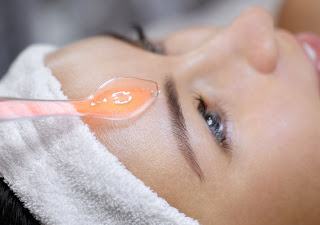As we know, treating acne requires a proper at-home skincare regimen, an understanding of our allergies and intolerances, and regular visits to an esthetician. A knowledgeable skin care professional will use a variety of professional products and modalities to deeply cleanse, exfoliate, de-congest, and disinfect the skin, as well as soothe and heal the inflammation associated with acne. There is a myriad of different devices and modalities available to perform a service for acneic skin, but I will focus on a few of the most commonly used among skincare professionals. You may check with your state’s Board of Cosmetology to see if a device is allowed to be used in your state by licensed estheticians, or just by medical personnel.
One of the first modalities we use in school is galvanic. Galvanic current is a constant and direct current (DC) that uses a positive and negative pole to produce the chemical reactions when it passes through tissues and fluids in the body. For acne clients, we use desincrustation. Desincrustation is a deep cleansing treatment that softens and emulsifies sebum, and is the ideal treatment for oily or congested skins preparing the skin for extractions. It should be done after cleansing the skin, using desincrustation fluid - a type of alkaline solution made from sodium chloride (table salt). Although this is a very commonly used machine in our scope of practice, don’t forget to make sure the client fills out the consultation form, and is not contraindicated to receive a galvanic treatment. Contraindications for using a galvanic device are: pregnancy, metal implants/pins in the face or body, epilepsy, pacemaker, and high blood pressure.

Another great way to cleanse the skin is by mode of ultrasonic exfoliation. An ultrasonic skin spatula or ultrasonic skin scrubber is a small hand-held device that features a thin plate that vibrates 28,000-30,000 Hz per second, and removes dead skin cells, dirt, and debris. The spatula works by creating high speed oscillations that extract pores without pain. For those clients with sensitive skin, ultrasonic exfoliation is a wonderful alternative to skin-cleansing brushes and microdermabrasion (both of which spread bacteria and aggravate redness and discomfort). The esthetician controls the pressure, angle and direction of the spatula to delicately work debris from the clients’ pores, focusing on problem areas and exfoliating the skin gently without aggressively brushing or peeling it. Since you are using water or a hydrating toner with the spatula, and not a gritty scrub, your clients’ skin will feel very clean and smooth after the treatment.
In addition to these devices, another basic tool we are all familiar with is the
high frequency machine. The
high frequency machine is used after extractions on clean skin, or over gauze to close the pores and kill germs and bacteria. High-frequency treatment uses low-current high-frequency alternating currents, delivered via a glass electrode.
Because the high frequency current converts some of the oxygen in the air into ozone, the treatment has a germicidal action, and is also drying and warming. Consequently, the treatment is used to aid healing and also to help desquamation and stimulate sweat and sebaceous glands. At up to 250,000 Hz frequency, the hollow glass electrode behaves like a glow discharge tube. When applied to the surface of the skin or scalp, a mild
high frequency current passes through the neon or argon gas filled glass electrode causing it to light up with a neon orange or argon purple glow.

Cleanse the skin first, exfoliate, and perform extractions. Then, after the extractions have been performed, treat blemished area by lightly whisking the glass bulb tip of your high frequency wand across the surface of the client’s skin using circular motions. Concentrate on larger blemishes and the areas most affected for at least 30-40 seconds. The total treatment time with a high frequency machine is 3-5 minutes, and treatments can be repeated every other day. Similarly to the galvanic machine, the contraindications for this device are: pregnancy, metal implants/pins in the face or body, epilepsy, pacemaker, high blood pressure.
To kill acne-causing bacteria, and reduce inflammation, one of the best modalities is LED – light emitting diode - a tiny computer chip encased in glass. Blue
LED therapy for acne is non-invasive, painless and requires no recovery time. It is safe for all skin types and tones, and requires only 5 -15 minutes. The best combination of
lights for acne is blue and red together – the blue kills germs and bacteria that cause acne, and the red renews the skin, and encourages new collagen production. Such lights are available for home use in a handheld, as well as panels for faster and more convenient treatment room services.



























